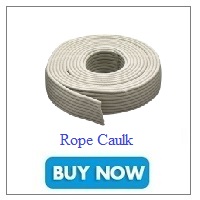 When you hear the word “putty,” does that bouncy, shapable toy you were always told not to get stuck on the floor come to mind? Hopefully, by the time you are finished reading you’ll have a different perspective of this word. Rope caulk is a putty substance that is less of a mess and more of an advantage around the house. When installed in the right places and at the most opportune time, caulk can relieve the stress on your home’s energy consumption and your energy bills.
When you hear the word “putty,” does that bouncy, shapable toy you were always told not to get stuck on the floor come to mind? Hopefully, by the time you are finished reading you’ll have a different perspective of this word. Rope caulk is a putty substance that is less of a mess and more of an advantage around the house. When installed in the right places and at the most opportune time, caulk can relieve the stress on your home’s energy consumption and your energy bills.
Why use it?
Balances home temperature
Have you ever felt like the temperature in your house was more extreme than it was outside? That’s a surefire sign that there might be air leaks throughout your home. Translation? When you turn up the AC or heater, all of that air is blowing out while the outside air is on its way in, causing three obvious problems:
- Defeats the purpose of the AC and heater
- Causes you unnecessary discomfort in your own home
- Raises your energy bill for every increase/decrease of degrees you change the AC or heater
You can easily (and cleanly) solve these problems by sealing air leaks with rope caulk.
Keeps out critters
Summer brings warm weather and longer days, but it’s also the season for bugs to come out and play. If (like me) you prefer for critters to play outside of your home, you should close up all potential areas of entry with caulk.
Great for renters (it’s a nonpermanent change)
For those of you living in a rental property and/or don’t want to make any long-term changes to your house, rope caulk is a non-permanent solution to insulating your home. Even better, the installation is easy, the removal is clean, and the caulk is durable. It comes in a gray or brown color.
Installation: How and when to use it
How to install rope caulk
- First, clean the area where you’ll use the rope caulk to prevent any dirt or grime from making the caulk less sticky and therefor less able to seal properly.
- Cut the amount of rope you need.
- Firmly press it into the crack/gap you want sealed.
When to install rope caulk
This isn’t written in stone, but it’s easier to install caulk during warm weather. The caulk is softer when warm and will stick into cracks and gaps much easier than it would when cold.
Mortite rope caulk adds a whole new meaning to “like putty in my hands,” and offers a whole new meaning to home insulation with its easy-to-install, energy efficient, and money saving qualities.

If installing the rope caulking in warmer weather is not possible and the caulk refuses to stick to the surface after proper cleaning then try warming the surface with a heat gun on a low setting.
Keep the gun moving and don’t get it too close to the surface; you don’t want to soften paint or melt or warp plastics. You only want to warm the surface enough to get the material to stick. I had some caulking come loose from a window; I just warmed it a little with a heat gun and was able to stick it back just fine.
I also found that warming the caulking on a metal or stone surface in front of a fireplace makes it more pliable and easier to to shape.
How does one store rope caulk? Is it best kept in a cool dark place, should I put it in a plastic bag, will it dry out? No instructions on the box, so I’m wondering. Thanks
how can you remove leftover rope caulk from door frame
Hi Patricia! Apply rubbing alcohol to the caulk. That should make it easier to scrape away.
I have large gaps around my windows. I was hoping to fill the gaps with caulking cord, then caulk over top of that with paintable caulk before painting my window trim. Will this work? Has anyone tried this before? I know the caulking cord doesn’t dry up, so I was unsure about doing this. Thanks!
It’s helpful that you said to clog up all possible areas of entry with caulk so you don’t have to worry about pests. I’ve had rodents before and it really wasn’t fun. I didn’t know you could use caulk to keep them out, but I’m glad you mentioned it!
You’ve made my life so simple by your easy explanation of the use of this product.Thank you so much. You have bought light to a sub novice experience.
How do you keep mortite rope caulking from sticking to your fingers when appling? The caulking is new, and temps are 50 to 60. This makes for a very tedious job. I’ve used this product for many, many years and now this bump in the road. I’ve taken to using a damp rag, way to much work, so any suggestions would rock!
Thank you!